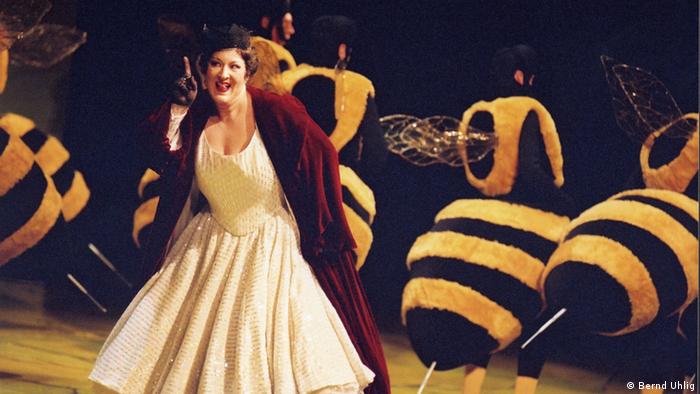Valentina ha scritto:ho appena finito di vedere il Lohengrin di Neuenfels
E sei ancora viva?
Scherzi a parte, è una regia sicuramente molto molto molto discutibile. Neuenfels è, oggi, forse il massimo esponente del Regietheater tedesco. Ha realizzato spettacoli che comunque hanno segnato la storia della regia d'opera (non c'è manuale di storia della drammaturgia teatrale che non ne sottolinei il ruolo dissacrante e innovativo).
E poi trovo ingiusto criticare questo... Rattengrin solo perché Neuenfels fa Neuenfels
Voglio dire, Neuenfels è autore di un Rigoletto con casa del gobbo edificata su un'isoletta tropicale con scatole di plexiglass,


e di un Nabucco ambientato in un alveare

Quanto a proposito della sua Aida,

vi rimando a quanto scrive Giudici:
http://books.google.it/books?id=8mQD95Z ... 20&f=false
E naturalmente non dimentichiamo l'Idomeneo in cui compare una testa di Maometto mozzata (che non mostro per paura che qualche integralista islamico ci bombardi il forum.
Per chi mussulmano un'immagine della testa incriminata (ed insanguinata) si trova qui:
http://operachic.typepad.com/opera_chic/hans_neuenfels/
Francamente, parlando di Neuenfels, non so nemmeno più che emoticon inserire.

















Il Rattengrin, al confronto, è roba da educande. Comunque molto meglio Neuenfels che molti suoi epigoni. Ciò detto, trovo Konwitschny molto molto più interessante e "centrato" e molto meno... onanista
Comunque, sempre a proposito di Neuenfels, riporto qui un paragrafetto da Cambridge Opera Journal, a firma Clemens Risi, intitolato: Hans Neuenfels and Peter Konwitschny Stage Verdi (And Verdians).
When considering recent Verdi performances, it is impossible not to begin with Hans Neuenfels, whose notorious 1981 production of Aida helped to open a new chapter in the history of opera - the chapter now known as Regietheater. The battle lines had been drawn as early as 1972, when a German operatic audience reacted with profound disapproval to G6tz Friedrich's innovative staging of a repertory classic, Tannhauser, which featured an almost naked Gwyneth Jones as Venus. Four years later, Patrice Chereau's centenary production of Der Ring des Nibelungen prompted even greater hostility. But the time was ripe. Productions that abandoned traditional staging tactics alienated some loyal fans, but also attracted a totally new and younger crowd.
We owe one of the best descriptions of Neuenfels' staging of the initial moments of the Act II Finale to Samuel Weber:
the curtain rises to reveal a surprising, indeed breathtaking tableau ... The chorus, ranged horizontally and vertically in a grid representing the Scala loges and covering most of the visible area, is placed at the very front of the stage, just behind the curtain ...
... the rising curtain reveals or, rather, confronts the audience with something like its mirror image: the original first-night audience of the opera's European premiere at La Scala in 1872 ... One audience looks at another. And the other stares back ... If the Frankfurt audience applauded the Scala simulacrum, the latter repaid the compliment at the end of its opening chorus, acknowledging the audience with hand waves of its own.
When I saw the performance in the mid-1980s, the historical dimension did not initially seem important. The impression of seeing an audience, my mirror image, was so overwhelming that only when the chorus retreated to the back of the stage did I notice that there was quite a difference in our outfits. By moving back through space, the chorus also went back into history and pulled me with it. Once members of the chorus had arranged themselves along the rear of the stage, the most controversial moment of the production transpired. The Ethiopian prisoners were led to a laid table and forced to use knives and forks in order to eat roasted chicken.
The experiment in civilization failed, the prisoners revolted, the chickens were thrown through the air, and the Egyptian military reacted with even harsher suppression of the uncivilized 'savages'. During every pause in the music the uproar caused by the audience almost necessitated the suspension of the performance. The audience used every possible means to make its displeasure actively known and heard. In this scene, we were confronted not only with a visual mirror image of a historical audience, but struck also by the mirror image of our own feeling of superiority and our own arrogance towards the 'Other'.
In sintesi, traduco dall'inglese, il fenomeno del Regietheater nasce con l'Aida di Neuenfels del 1981. In una scena del finale II di questa Aida, i prigionieri etiopi sono costretti ad usare coltello e forchette per mangiare pollo arrosto di fronte ai civilizzati Egizi, disposti su palchi che riproducono quelli del Teatro alla Scala, teatro in cui Aida venne rappresentata la prima volta nel 1872). Naturalmente, l'esperimento di civilizzazione fallisce miseramente, e cosciotti ed ali di pollo finiscono per volare in aria e in faccia al pubblico in sala
DM


